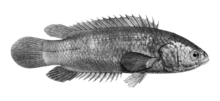Climbing gourami
| Climbing gouramies | |
|---|---|

| |
| Anabas testudineus | |
| Scientific classification | |
| Kingdom: | |
| Phylum: | |
| Class: | |
| Order: | |
| Suborder: | |
| Family: | Anabantidae
|
| Genera | |
|
Anabas | |
The Anabantidae are a family of perciform fish commonly called the climbing gouramies or climbing perches. As labyrinth fishes, they possess a labyrinth organ, a structure in the fish's head which allows them to "breathe" atmospheric oxygen. Fish of this family are commonly seen gulping at air at the surface of the water; which then passes out of their gills or mouth when they dive beneath the surface.
The climbing gouramies originate from Africa to India and the Philippines. They are primarily a freshwater fish and only very rarely found in brackish water. An egg-layer, they typically guard their eggs and young.
Climbing Gouramis are so names due to their ability to "climb" out of water and "walk" short distances. Their method of terrestrial locomotion uses the gill plates as supports and the fish pushs itself using the fins and tail.
Species
There are about 36 species in the family, classified in four genera (three according to some authors). The familiar aquarium resident, the Siamese Fighting Fish Betta splendens used to be classified in this family, but is now placed among the gouramies, family Osphronemidae.
- Genus Anabas
- Gangetic koi, Anabas cobojius (Hamilton, 1822).
- Climbing perch, Anabas testudineus (Bloch, 1792).
- Genus Ctenopoma
- Spotted ctenopoma, Ctenopoma acutirostre Pellegrin, 1899.
- Silverbelly ctenopoma, Ctenopoma argentoventer (Ahl, 1922).
- Ctenopoma ashbysmithi Banister & Bailey, 1979.
- Ctenopoma breviventrale (Pellegrin, 1938).
- Ctenopoma ctenotis (Boulenger, 1920).
- Ctenopoma garuanum (Ahl, 1927).
- Tailspot ctenopoma, Ctenopoma kingsleyae Günther, 1896.
- Ctenopoma machadoi (Fowler, 1930).
- Ctenopoma maculatum Thominot, 1886.
- Manyspined ctenopoma, Ctenopoma multispine Peters, 1844.
- Ocellated labyrinth fish, Ctenopoma muriei (Boulenger, 1906).
- Ctenopoma nebulosum Norris & Teugels, 1990.
- Twospot climbing perch, Ctenopoma nigropannosum Reichenow, 1875.
- Eyespot ctenopoma, Ctenopoma ocellatum Pellegrin, 1899.
- Mottled ctenopoma, Ctenopoma oxyrhynchum (Boulenger, 1902).
- Ctenopoma pellegrini (Boulenger, 1902).
- Ctenopoma petherici Günther, 1864.
- Ctenopoma riggenbachi (Ahl, 1927).
- Ctenopoma togoensis (Ahl, 1928).
- Ctenopoma weeksii Boulenger, 1896.
- Genus Microctenopoma
- Ornate ctenopoma, Microctenopoma ansorgii (Boulenger, 1912).
- Congo ctenopoma, Microctenopoma congicum (Boulenger, 1887).
- Microctenopoma damasi (Poll & Damas, 1939).
- Banded ctenopoma, Microctenopoma fasciolatum (Boulenger, 1899).
- Microctenopoma intermedium (Pellegrin, 1920).
- Microctenopoma lineatum (Nichols, 1923).
- Microctenopoma milleri (Norris & Douglas, 1991).
- Dwarf ctenopoma, Microctenopoma nanum (Günther, 1896).
- Microctenopoma nigricans Norris, 1995.
- Microctenopoma ocellifer (Nichols, 1928).
- Microctenopoma pekkolai (RendAhl, 1935).
- Microctenopoma uelense Norris & Douglas, 1995.
- Genus Sandelia
- Eastern Cape Rocky, Sandelia bainsii Castelnau, 1861.
- Cape kurper, Sandelia capensis (Cuvier, 1829).
References
- "Anabantidae". Integrated Taxonomic Information System. April 28.
{{cite web}}: Check date values in:|date=and|year=/|date=mismatch (help) - Froese, Rainer; Pauly, Daniel (eds.). "Family Anabantidae". FishBase. September 2004 version.
